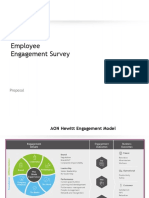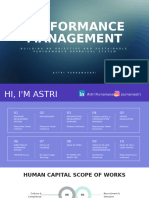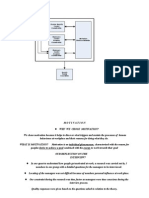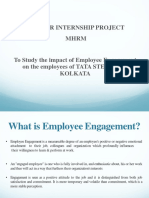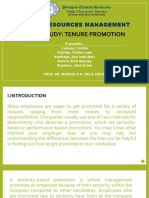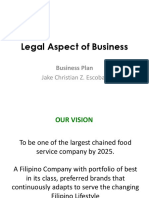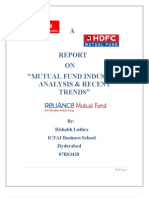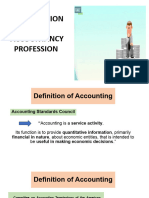Say Stay or Strive Health Aon
Say Stay or Strive Health Aon
Uploaded by
Doris YanCopyright:
Available Formats
Say Stay or Strive Health Aon
Say Stay or Strive Health Aon
Uploaded by
Doris YanOriginal Title
Copyright
Available Formats
Share this document
Did you find this document useful?
Is this content inappropriate?
Copyright:
Available Formats
Say Stay or Strive Health Aon
Say Stay or Strive Health Aon
Uploaded by
Doris YanCopyright:
Available Formats
Aon Hewitt
Performance, Reward & Talent Proprietary and Confidential
Say, Stay, or Strive?
Unleash the Engagement Outcome You Need
June 2015
Risk. Reinsurance. Human Resources.
Aon Hewitt
Performance, Reward & Talent Proprietary and Confidential
Managers face many challenges in determining how to act upon engagement survey results. Overly
simplistic views of engagement as a generic indicator of morale or happiness often fail. Building off of our
Say, Stay, and Strive behavioral model of engagement, a starting place may be to determine and better
understand the type of engagement outcome you need.
For instance, one manager may have an employee who is incredibly hardworking but needs to say more
positive things about the company due to his/her network impact on peers. Another manager may have
employees who generally seem positive about the company and committed to staying, but need to ramp
up individual effort toward the new performance behaviors required by an organizational transformation.
To assess how to drive different engagement outcomes, we analyzed the relative predictive weight of
each of our 15 core driver categories1 using responses from over 300,000 employees representing 57
countries, 495 companies, and 63 industries. The results, shown in Figure 1, demonstrate the top drivers
for engagement overall as well as each of the most significant drivers for the outcomes in our Say, Stay,
and Strive engagement model (i.e., we find that engaged employees say positive things about the
company, stay with the organization, and strive to go above and beyond).
Figure 1—Rank Order of the Relative Weight of Drivers Across Engagement and Say/Stay/Strive
Driver Engagement
Rank Overall Say Stay Strive
1 EVP Reputation EVP EVP
Performance
2 Reputation EVP Work Fulfillment
Management
3 Work Fulfillment Work Fulfillment Reputation Work Fulfillment
Performance
4 Management
Diversity & Inclusion Career Opportunities Reputation
5 Career Opportunities Talent & Staffing Rewards Enabling Infrastructure
The analysis uncovers that while having a compelling employee value proposition (EVP), company
reputation, and fulfilling work are top drivers across all outcomes, they can vary in importance depending
on the specific engagement outcome desired.
For example, reputation is the top driver in motivating employees to say positive things about the
organization, but it is not as important in encouraging them to strive. Further, we find that some drivers
are unique to each of the three types of engagement outcomes (these drivers are shown in green). We
see that rewards are a unique driver for an employee to stay with an organization, and enabling
infrastructure is uniquely important for an employee to strive to go above and beyond.
1
Driver categories include career opportunities, collaboration, diversity and inclusion, EVP, empowerment, enabling infrastructure,
learning and development, manager, performance management, reputation, rewards and recognition, senior leadership, talent and
staffing, work fulfillment, and work/life balance.
Say, Stay, or Strive?
1
Aon Hewitt
Performance, Reward & Talent Proprietary and Confidential
Take Action
So, what does this mean for a manager? First, the employee value proposition (EVP), reputation, and
fulfilling work are critical across all engagement outcomes. Managers should take opportunities to clarify a
compelling promise to employees (or design an articulated EVP if it does not already exist), elucidate the
positive aspects of what the organization is known for in the market, and connect these two to a sense of
purpose for the employee.
But second—and equally important—managers need to take a tailored approach if there are unique
engagement outcomes of interest.
Let’s take a deeper dive into the unique drivers of different engagement outcomes.
The figure below summarizes common and unique drivers for engagement outcomes based on further
item-level analysis within driver categories. Based on this analysis and our deep human capital
experience, tangible action areas are provided for the type of engagement you need to make happen.
Figure 2—Common and Unique Drivers for Engagement Outcomes
If you need employees to… …you need to address these unique drivers
• Unique Drivers: Diversity &
Inclusion, and Talent & Staffing
Core Engagement • Hire great talent that will contribute
Drivers
-
-
EVP
Reputation
Say • Include people with diverse
opinions and backgrounds
- Work Fulfillment • Unique Drivers: Career
Opportunities and Rewards &
Stay
Recognition
• Create a compelling • Outline career paths with timelines
employment compact and requirements
• Demonstrate social • Recognize contributions and value
responsibility in the
community
• Unique Drivers: Performance
• Foster a sense of
accomplishment and
purpose
Strive management and Enabling
Infrastructure
• Provide line of sight between
individual and organizational goals
• Enable development of ideas and
new skills
What Employees Need to Advocate for Your Company (Say)
In addition to the common drivers across engagement outcomes, it appears that talent management is
very important for inspiring employees to say positive things about your company. Specifically, having a
diverse talent pool and sufficient colleagues with the right skills to get the job done will drive employees to
become advocates for your company. While promoting and retaining key talent are important, it is crucial
to attract the right people to achieve your business goals.
Say, Stay, or Strive?
2
Aon Hewitt
Performance, Reward & Talent Proprietary and Confidential
What Employees Need to Continue Providing Their Talents to
Your Company (Stay)
Career opportunities are uniquely important for employees to stay. Great employees either will stay and
advance with their current company, or will leave and find these opportunities elsewhere.
We also see rewards and recognition as uniquely important for employees to stay—in particular, non-
monetary recognition can be a more important driver of retention than compensation. This means that
focusing on improving the perceptions of future career opportunities and ensuring appropriate rewards
not only improves engagement, but also specifically improves the likelihood that employees will stay.
What Employees Need to Focus Their Energy and Effort Toward
Exceptional Performance (Strive)
Getting the most out of employees requires performance focus and enablement. Performance
management that clarifies objectives, creates line of sight, and provides useful feedback is highly
important for employees to strive.
Employees are also more likely to give extra effort if there are systems in place that enable them to
contribute. Protracted processes and/or lack of resources have been shown to frustrate employees and
stifle discretionary effort.
Final Thoughts
As we have seen, employee engagement has different facets and behavioral outcomes. Managers often
find themselves needing to emphasize one outcome (like getting top talent to stay with an organization)
over another (such as striving to go above and beyond). Understanding these nuances requires
measurement, insight, and action in the areas that matter most to the outcome in question.
The analysis in this paper presents insights and prescriptions for action for three important engagement
outcomes—say, stay, and strive.
Say, Stay, or Strive?
3
Aon Hewitt
Performance, Reward & Talent Proprietary and Confidential
Contact Information
Ken Oehler, PhD
Global Engagement Practice Leader
Performance, Reward & Talent
ken.oehler@aonhewitt.com
Christopher Adair, PhD
Consultant, Engagement Practice
Performance, Reward & Talent
christopher.adair1@aon.com
Say, Stay, or Strive?
4
Aon Hewitt
Performance, Reward & Talent Proprietary and Confidential
About Aon Hewitt
Aon Hewitt empowers organizations and individuals to secure a better future through innovative talent,
retirement, and health solutions. We advise, design, and execute a wide range of solutions that enable
clients to cultivate talent to drive organizational and personal performance and growth, navigate
retirement risk while providing new levels of financial security, and redefine health solutions for greater
choice, affordability, and wellness. Aon Hewitt is the global leader in human resource solutions, with over
30,000 professionals in 90 countries serving more than 20,000 clients worldwide. For more information on
Aon Hewitt, please visit aonhewitt.com.
Copyright 2015 Aon Inc.
Placeholder for copyright
Say, Stay, or Strive?
5
You might also like
- "H. J. Heinz M&A": Case StudyDocument8 pages"H. J. Heinz M&A": Case StudySudhanva S 1510214100% (10)
- EntrepreneurialVentures - P S SanjanaDocument41 pagesEntrepreneurialVentures - P S SanjanaSanjana100% (1)
- Employee Engagement Survey - ProposalDocument7 pagesEmployee Engagement Survey - ProposalMarius-Leonard Motofei-RaduNo ratings yet
- Performance ManagementDocument30 pagesPerformance ManagementDikkaRamadhanNo ratings yet
- How To Select and Develop High Potential LeadersDocument10 pagesHow To Select and Develop High Potential LeadersZainab Yousaf Zai100% (1)
- Banco Filipino Group 2 Am4Document10 pagesBanco Filipino Group 2 Am4Kim Carlo F. Tangian100% (1)
- Employee Engagment in OrganisationDocument12 pagesEmployee Engagment in OrganisationRitto RexyNo ratings yet
- Employee Engagment in OrganisationDocument12 pagesEmployee Engagment in OrganisationRitto RexyNo ratings yet
- Rev - 2 Ragu KDocument31 pagesRev - 2 Ragu Ksvenu8349No ratings yet
- HR Mangement-Employee DevelopmentDocument21 pagesHR Mangement-Employee DevelopmentAnant JainNo ratings yet
- Performance ManagementDocument18 pagesPerformance ManagementAkshayNo ratings yet
- PM_DasparDocument13 pagesPM_DasparDaspar DasparNo ratings yet
- HR ReviewerDocument11 pagesHR ReviewerChrista Felicia AldayNo ratings yet
- From Employee Engagement To Employee EffectivenessDocument11 pagesFrom Employee Engagement To Employee EffectivenessjameelkakaNo ratings yet
- The Case For Employer BrandingDocument47 pagesThe Case For Employer BrandingkirtiNo ratings yet
- WK10 Workforce TQMDocument60 pagesWK10 Workforce TQMKohi BangNo ratings yet
- 579846150_TX_Strategy_HR_v3_4155348916010366Document17 pages579846150_TX_Strategy_HR_v3_4155348916010366Bilal YounisNo ratings yet
- Implementing Business ExcellenceDocument48 pagesImplementing Business ExcellenceRoma BisoNo ratings yet
- 1-Total Rewards & Pay Model Presentation - 12 Jan 2024Document25 pages1-Total Rewards & Pay Model Presentation - 12 Jan 2024Sahil SinghhNo ratings yet
- Chapter 3 Workforce FocusDocument24 pagesChapter 3 Workforce FocuscynangelaNo ratings yet
- Developing and Sustaining Employees EngagementDocument11 pagesDeveloping and Sustaining Employees EngagementJabri JuhininNo ratings yet
- MCD Part I Slide for StudentsDocument136 pagesMCD Part I Slide for StudentsShreya GuptaNo ratings yet
- Organizational Behavior V2.0: by Talya Bauer and Berrin ErdoganDocument38 pagesOrganizational Behavior V2.0: by Talya Bauer and Berrin ErdoganPrecious SuccorNo ratings yet
- Unit IV HRDDocument10 pagesUnit IV HRDVatsala SNo ratings yet
- Performance Management Incorporating Competencies: Employee and Manager GuideDocument16 pagesPerformance Management Incorporating Competencies: Employee and Manager Guidearsyad.arrivalNo ratings yet
- Manual de Emerging LeaderDocument52 pagesManual de Emerging LeaderbrunoskibskiNo ratings yet
- Mppo Evp CrisilDocument16 pagesMppo Evp Crisilhagar sudha100% (1)
- SHRM Team 3 PresentationDocument16 pagesSHRM Team 3 PresentationSushmaNo ratings yet
- Abraham Joseph and Prasanth Presentation On Motivation at Work and Designing Motivating JobsDocument11 pagesAbraham Joseph and Prasanth Presentation On Motivation at Work and Designing Motivating JobsVenkat 19P259No ratings yet
- 3 HR Pros Guide To KPIsDocument22 pages3 HR Pros Guide To KPIsAbdul MalikNo ratings yet
- Avon Case StudyDocument7 pagesAvon Case StudyShounak DashNo ratings yet
- CH 10 OnwardsDocument24 pagesCH 10 OnwardsWaLed AbbaCyNo ratings yet
- 11 PMA 112608 KLDocument2 pages11 PMA 112608 KLgrowth.pandoraNo ratings yet
- Employer BrandingDocument18 pagesEmployer BrandingShainesh_Sharm_396186% (7)
- Performance ManagementDocument124 pagesPerformance Managementeshetu mohNo ratings yet
- HRM Case StudyDocument20 pagesHRM Case StudySNEHA GAJBHIYENo ratings yet
- Flexible Benefits: Context CharacteristicsDocument7 pagesFlexible Benefits: Context CharacteristicsUnjan_RahiNo ratings yet
- Leadership and Strategic Planning: DR Ali SajidDocument130 pagesLeadership and Strategic Planning: DR Ali SajidSandy CelineNo ratings yet
- Performance Management Unit 4Document31 pagesPerformance Management Unit 4beviNo ratings yet
- Summer Internship Project MHRMDocument41 pagesSummer Internship Project MHRMnamrata dasNo ratings yet
- Career DevelopmentDocument39 pagesCareer DevelopmentAgung setyaNo ratings yet
- Talent Management: Key To Strategy & Performance Improvement SuccessDocument6 pagesTalent Management: Key To Strategy & Performance Improvement Successkavitharaj017No ratings yet
- Performance On Our Pulse! Framework To Management PerformanceDocument10 pagesPerformance On Our Pulse! Framework To Management PerformanceMulusaNo ratings yet
- CASE STUDY - Tenure PromotionDocument11 pagesCASE STUDY - Tenure PromotionTrish GarridoNo ratings yet
- Coaching and Potential AppraisalDocument6 pagesCoaching and Potential AppraisalLaxmi Choudhary100% (1)
- CH 3Document19 pagesCH 3keren chauhanNo ratings yet
- HRM 400 B Group 1Document21 pagesHRM 400 B Group 1Rogeilyn CalimpongNo ratings yet
- Total Compensation/Reward Reward Strategy Factors Affecting Compensation & Process of Pay DeterminationDocument50 pagesTotal Compensation/Reward Reward Strategy Factors Affecting Compensation & Process of Pay Determinationrishi_rewaNo ratings yet
- 4-The Impact of Employee Motivation On Organization PerformanceDocument20 pages4-The Impact of Employee Motivation On Organization PerformancesurangauorNo ratings yet
- (KADO) HR7SL64O-21598794-Assesment 01Document16 pages(KADO) HR7SL64O-21598794-Assesment 01Krishan hunukumburaNo ratings yet
- Employee Well Being - Instructors SlidesDocument21 pagesEmployee Well Being - Instructors SlidesRianne SpringerNo ratings yet
- HRM 400 ReviewerDocument9 pagesHRM 400 ReviewerRogeilyn CalimpongNo ratings yet
- HR Causal Chain (Line Managers)Document23 pagesHR Causal Chain (Line Managers)Mariyam MoosaNo ratings yet
- Managing The Multigenerational WorkforceDocument6 pagesManaging The Multigenerational WorkforceEilyn LavínNo ratings yet
- Project Report On Performance Appraisal System On OppoDocument256 pagesProject Report On Performance Appraisal System On OppoNikhil Shrivastava100% (1)
- Human Resource Management: Shah M Saad HusainDocument48 pagesHuman Resource Management: Shah M Saad HusainAnnie KhowajaNo ratings yet
- Performance CoachingDocument16 pagesPerformance CoachingJuhjiz SinghNo ratings yet
- HrmsDocument16 pagesHrmsRashmeet KaurNo ratings yet
- An Introduction: Competence-Based Human Capital Management (CB-HCM)Document28 pagesAn Introduction: Competence-Based Human Capital Management (CB-HCM)rizky niarNo ratings yet
- Faw MotorsDocument12 pagesFaw Motorstazeen fatima RizviNo ratings yet
- Best Practices: Evaluating Performance: How to Appraise, Promote, and FireFrom EverandBest Practices: Evaluating Performance: How to Appraise, Promote, and FireRating: 5 out of 5 stars5/5 (2)
- 5419 N Sheridan RD Chicago, IL 60640-1917 773-878-7340 Restaurant Personnel IncDocument2 pages5419 N Sheridan RD Chicago, IL 60640-1917 773-878-7340 Restaurant Personnel IncLizbhet Paz100% (1)
- Public Procurement and Competition LawDocument38 pagesPublic Procurement and Competition LawIndianAntitrustNo ratings yet
- Preparation of Final AccountsDocument13 pagesPreparation of Final AccountsDr Sarbesh MishraNo ratings yet
- Swift MT940 DocDocument27 pagesSwift MT940 DocGNV Engg ServicesNo ratings yet
- MGT657 Chapter8Document21 pagesMGT657 Chapter8adamNo ratings yet
- Module 1 AssignmentDocument6 pagesModule 1 AssignmentAbhishek KumarNo ratings yet
- Strategy 1Document2 pagesStrategy 1Jigar NagvadiaNo ratings yet
- Strategic Management 6Document158 pagesStrategic Management 6zakria100100No ratings yet
- Marginal CallDocument3 pagesMarginal Calllexredondo22No ratings yet
- The Philippine Financial Reporting Standards: PFRS Updates TrainingDocument74 pagesThe Philippine Financial Reporting Standards: PFRS Updates TrainingMara Shaira Siega100% (1)
- Gift Ifsc Ifsca Fund Management Regulations 2022Document10 pagesGift Ifsc Ifsca Fund Management Regulations 20228b2mdnkyjbNo ratings yet
- Partnership Dissolution: Prepared By: Cristopherson A. Perez, CPADocument59 pagesPartnership Dissolution: Prepared By: Cristopherson A. Perez, CPAKyla de SilvaNo ratings yet
- Quantitative Problems Chapter 12Document12 pagesQuantitative Problems Chapter 12AndrewVazNo ratings yet
- Capacity Management - IsO20K-Assessment Q'ReDocument28 pagesCapacity Management - IsO20K-Assessment Q'ReRuben MaximusNo ratings yet
- Unit 2 (Complete)Document16 pagesUnit 2 (Complete)Tushar BhattacharyyaNo ratings yet
- JP MorganDocument21 pagesJP MorganHarsh PathakNo ratings yet
- USIM Degree of AccountingDocument4 pagesUSIM Degree of AccountingNurul Ain'No ratings yet
- Business Plan - JCE - GMB717Document30 pagesBusiness Plan - JCE - GMB717JAKE CHRISTIAN ESCOBARNo ratings yet
- Final Report (Trial)Document102 pagesFinal Report (Trial)Siddharth MalikNo ratings yet
- Uniform System of Accounts Restaurant USARDocument15 pagesUniform System of Accounts Restaurant USARHector RiveraNo ratings yet
- Chapter 5 Financial Markets and InstitutionsDocument12 pagesChapter 5 Financial Markets and InstitutionsHamis Rabiam MagundaNo ratings yet
- ECC-Complete Managed SBLC ProgramDocument19 pagesECC-Complete Managed SBLC ProgramEcho CapitalNo ratings yet
- Intro To Accountancy Profession.fDocument16 pagesIntro To Accountancy Profession.fSURSECO UNONo ratings yet
- Gstam IDocument6 pagesGstam Iagi.acc.head01No ratings yet
- ITIL - 11-2018 - FinalDocument79 pagesITIL - 11-2018 - FinalhoanganhsonNo ratings yet
- Linkedin State of Sales Us NewDocument16 pagesLinkedin State of Sales Us NeweyxvoerzqgfmtapzsxNo ratings yet
- Abdulfetah ResearchDocument45 pagesAbdulfetah Researchamde haymanotNo ratings yet


